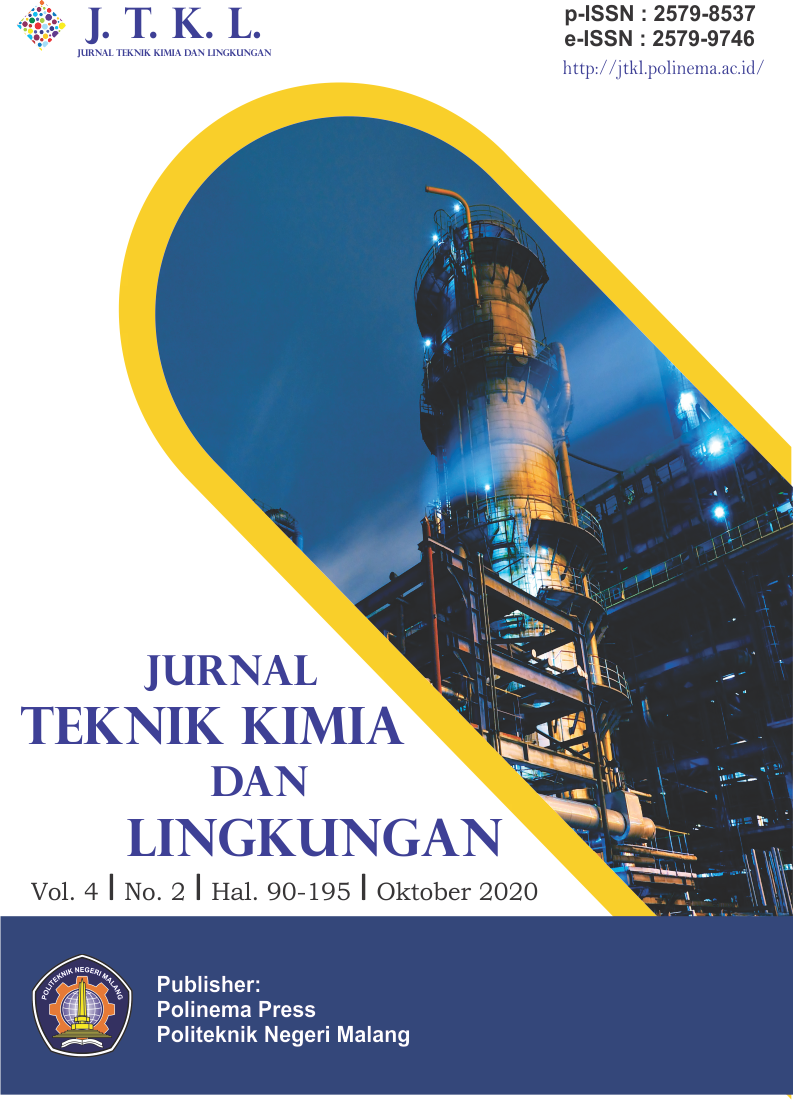Karakteristik Hydrocyclone untuk Pemisahan Minyak dan Air
DOI:
https://doi.org/10.33795/jtkl.v4i2.160Keywords:
hydrocyclone, liquid-liquid separation, separation of petroleum from waterAbstract
Eksplorasi minyak bumi dari sumur-sumur yang sudah tua menghasilkan minyak dengan kandungan air tinggi. Hydrocyclone suatu alat yang berfungsi untuk pemisahan cair-cair berdasarkan perbedaan berat jenis setiap komponen. Pemisahan ini terjadi dikarenanakan adanya gaya sentrifugal dan gaya gravitasi yang dihasilkan dari bentuk hydrocyclone yang seperti kerucut. Perancangan dan pembuatan hydrocyclone menghasilkan alat dengan spesifikasi sebagai berikut : diameter pipa masukan : 25,4 mm, diameter cylindrical section : 120 mm, tinggi cylindrical section : 120 mm, tinggi cone section : 600 mm, diameter pipa overflow : 25,4 mm, diameter pipa underflow : 25,4 mm. Laju alir optimum untuk pemisahan air-minyak tanah pada hydrocyclone adalah 91,8 liter/menit dengan kadar minyak tanah di overflow sebesar 11,4% dan kadar minyak tanah di underflow sebesar 3%.
Petroleum exploration from old wells produces oil with a very high water content. Hydrocyclone is a device that functions for liquid-liquid separation based on differences in specific gravity of each component. This separation occurs due to the presence of centrifugal forces and gravitational forces resulting from cone-like forms of hydrocyclone. The design and manufacture of hydrocyclone produces tools with the following specifications: input pipe diameter: 25.4 mm, cylindrical section diameter: 120 mm, high cylindrical section: 120 mm, cone section height: 600 mm, overflow pipe diameter: 25.4 mm, underflow pipe diameter: 25.4 mm. The optimum flow rate for the separation of water-kerosene on hydrocyclone is 91.8 liters / minute with the level of kerosene in overflow of 11.4% and the level of kerosene in underflow of 3%.
References
A. Sholikin, Otonomi Daerah dan pengelolaan minyak bumi di Kabupaten Bojonegoro, Jurnal Ilmu Administrasi, vol. 15, no.1, hal. 35-50, 2018.
M.H. Ramadhan, A. Widyaparaga, Studi eksperimental terhadap unjuk kerja dari liquid-liquid cylindrical cyclone (LLCC) sebagai separator air dan minyak, M.Eng. thesis, Teknik Mesin, Universitas Gajah Mada, Yogyakarta, 2017.
M.F. Sidiq, Analisa pengendalian laju korosi pada pipa minyak bumi lepas pantai, J. Sain dan Tek. Maritim, vol. 10, no.1, hal. 11-12, 2011.
S. Sutikno, Optimasi perancangan model hidraulika untuk memisahkan limbah minyak pada air buangan, J. Sains & Tek., vol. 4, no. 2, hal. 53-57, 2005.
A.S. Nugroho, F. Faridah, K. Suryopratomo, Rancang bangun sensor pengukur level interface air dan minyak pada mini plant separator, Teknofisika, vol. 2 , no. 2, hal. 42-54, 2013.
G. Gerdes, A. DeGuzman, J. Grubich, Designing coalescing oil/water separators for use at army washracks, US Army Corps Of Engineers, 2000.
L.G.M., Vieira, E.A. Barbosa, J.J. Damasceno, M. Barrozo, Performance analysis and design of filtering hydroclones, Braz. J. Chem. Eng., vol. 22, no. 1, hal. 143-152, 2005.
O.S. Motsamai, Investigation of the influence of hydrocyclone geometric and flow parameters on its performance using CFD, Sage Journal, vol. 2010, hal. 1-12, 2010.
S. Masyam, M. Reza, F. Bijan, Numerical investigation of cone angle effedt on the flow field and separation efficiency of deoiling hydrocyclones, Heat Mass Transfer, vol. 49, no. 2, hal. 247-260, 2013.
J.S. Souza, M.K.N. Paiva, F.P.M. Farias, S.R.F. Neto, A.G.B. Lima, Hydrocyclone Applications in Produced Water: A Steady-State Numerical Analysis, Brazilian Journal of Petroleum and Gas, vol. 6, no. 3, hal. 133-143, 2012.
D.K. Mccluskey, A.E. Holdo, Optimizing the hydrocyclone for ballast water treatment using computational fluid dynamic, Int. J. of Multiphys, vol. 2, hal. 221-234, 2009.
H. Jun, A. Lian-suo, W. Zhi-quan, Study on application and operation optimization of hydrocyclone for solid- liquid separation power plant, in: WCECS, (the World Congress on Engineering and Computer Science) San Fransisco USA, Oct. 2009.
J.C. Caldentey, A mechanistic model for liquid hydrocyclones (LHC), University of Tulsa, 2000.
J. Jiang, R. Ying, J. Feng, W. Wang, Computational and experimental study of the effect of operating parameters on classification performance of compound hydrocyclone, Mathematical Problems in Engineering, vol. 2018, hal. 1-16, 2018.
L. Svarovsky, Solid-liquid separation, Woburn: Butterworth-Heinemann, 2000.
J. Dueck, A.V. Krokhina, L.L.Minkov. Controlling characteristics of hydrocyclone via additional water injection, Theor. Found. Chem. Eng., vol. 46, no. 3, hal. 342–352, 2012.
A. Kusmayanti, Pengaruh panjang cone dan tekanan pada hydrocyclone dalam menurunkan total suspended solid, Undergradute thesis, Dept. Environ. Eng. Institut Teknologi Sepuluh Nopember, Surabaya, 2014.
C.J. Geankoplis, Transport Processes and Unit Operation 3rd edition, New Jersey: Prentice-Hall International, Inc. 1993.
Downloads
Published
Issue
Section
License
Copyright (c) 2023 Dian Ratna Suminar, Nurcahyo Nurcahyo

This work is licensed under a Creative Commons Attribution-NonCommercial 4.0 International License.







